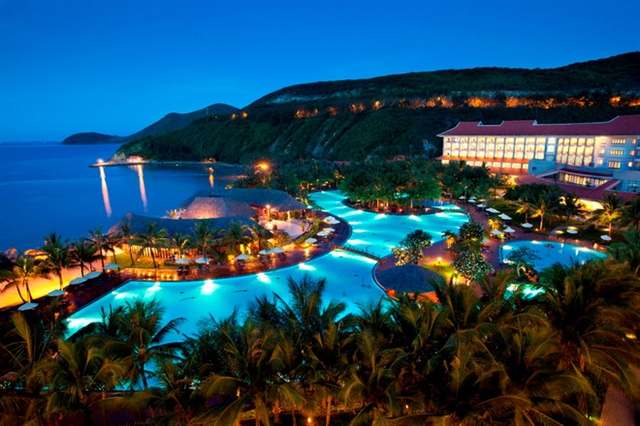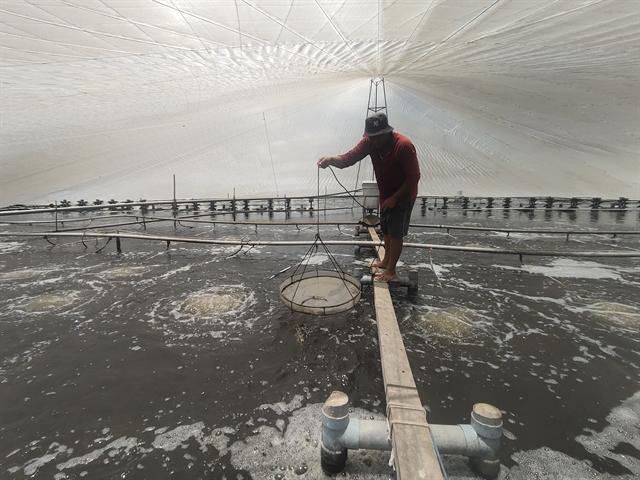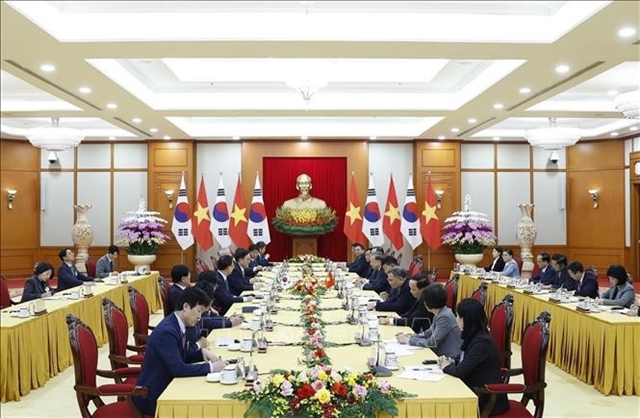 Society
Society

 |
| A high-tech shrimp pond covered in plastic for environmental control in Bến Tre Province. — VNA/VNS Photo Huỳnh Phúc Hậu |
BẾN TRE — Farmers in the Mekong Delta province of Bến Tre are increasingly switching to high-tech shrimp breeding, adopting more innovative techniques to boost productivity, reduce costs and increase incomes.
They use aerators, advanced equipment such as automatic feeders and other modern techniques to improve efficiency.
They have also started using innovative methods such as chlorine gas to treat water, and installing plastic over the ponds to help reduce environmental impacts.
Compared to powdered chlorine, chlorine gas dissolves more evenly, is less toxic, costs three to four times less, and reduces the area of pond needed for water treatment.
As a result, the shrimp are healthier, yields are higher, and costs and land use are reduced, according to local farmers.
Lê Văn Sấm, who owns 45ha for high-tech shrimp farming in Thạnh Phú District’s Thành Hải Commune, uses chlorine gas and has plastic over the ponds.
These methods have enabled him to save VNĐ1.5 billion (US$57,800) annually on chlorine and manage disease outbreaks more effectively by isolating infected ponds, he said.
Previously, without plastic covering, if disease struck a pond and the shrimp died, birds would feed on the infected shrimp and then fly to other ponds, spreading the disease and making it difficult to control, he explained.
The plastic also helps stabilise temperatures, making it easier to breed shrimp during the off-season, he said.
“Since applying these two techniques, I have seen significant reduction in costs while productivity has increased, resulting in a 15–20 per cent boost in economic efficiency compared to before.”
Nguyễn Văn Bàn, chairman of the Bến Tre Farmers Association, said the association has been expanding the use of innovative techniques among its members.
He said it would continue promoting effective shrimp farming models and innovative methods to more farmers, aiming to increase both the quantity and quality of shrimp for domestic consumption and export markets.
The Provincial People’s Committee is accelerating the implementation of its plan to develop 4,000ha of high-tech brackish water shrimp farming in 2021–25 to reach the 4,000ha target by the second quarter of this year with an expected output of 144,000 tonnes.
It currently has 3,633ha with average productivity of 60-70 tonnes per hectare, and average profits of VNĐ700–800 million ($27,000–31,000) per crop, offering substantial incomes for farmers.
Nguyễn Văn Buội, deputy director of the Provincial Department of Agriculture and Environment, said the province has invested VNĐ250 billion ($9.6 million) in irrigation, electricity and roads to support more than 3,000ha of concentrated brackish water shrimp farming areas in the coastal districts of Bình Đại and Ba Tri.
The department has also collaborated with export processing companies to help farmers breed shrimp to ASC and BAP standards.
The province has 575ha of shrimp farming areas certified to ASC or BAP standards, with their output fetching VNĐ2,000–10,000 per kilogramme more than the market price.
By 2030 the province aims to establish five high-tech shrimp farming zones covering a total area of nearly 3,400ha and funded by private investors in the districts of Bình Đại, Ba Tri, and Thạnh Phú.
It will also leverage existing infrastructure to assist the development of farm-scale and household-based high-tech shrimp farming models of 2–10ha each in various communes across these three districts.
The province is currently attracting investment in shrimp fry production in Bình Đại and Ba Tri districts, with the goal of producing 15 billion high-quality fry by 2025 (meeting 60 per cent of the province’s demand) and 20 billion by 2030 (meeting 70 per cent).
The province is home to 52 aquatic species fry production facilities, 44 of which specialize in brackish water shrimp. However, only three operate on a large scale, each with an annual capacity ranging from 2 to 4 billion fry.
In terms of shrimp processing, the province is strengthening the links between farming areas and processing plants.
It is also encouraging investment in three processing plants at the Phú Thuận Industrial Park in Bình Đại District, each with a capacity of 36,000 tonnes per year.
The province aims to process over 100,000 tonnes of shrimp annually and achieve shrimp exports of $1.2 billion this year.
By 2030, it targets 150,000 tonnes of processed shrimp and $1.8 billion in exports.
The province has 65km of coastline and over 50,000ha of potential aquaculture area, according to the department.
More than 90 per cent of the province’s farmed aquatic species have high economic value and good quality, serving the export processing sector. — VNS




